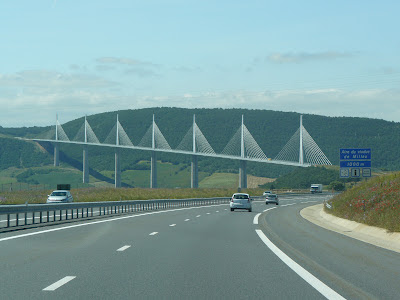 |
| Truckstop fare |
In many countries a road trip can often mean too few food choices, or too many (unappetising) options for eating. Not so at the French motorway gas and food fuelling stops! The photos show a small selection of what is on offer at one of the larger pit stops on our route north into the Haut-Languedoc. A little more lavish than a meat pie at Waiouru. And why not have a drink before hitting the road? At least the sign (not shown) states that wine will only be sold with meals. Having left the fast road and then wound our way through the Gorges of Tarn and over vertical (almost) rock cliffs, saddles and mountains in the Haut-Languedoc, we head south a few days later.
 |
| And a little wine with lunch before you drive on |
 |
| Truckstop fare - dessert better than many restaurants |
One of the most spectacular sites on the journey south is not one nature developed, but one designed and built by man. The Millau Viaduct deserves the word awesome. Spanning the Tarn valley at 343 metres high and 2.5km long, the viaduct is a beautiful piece of design (Norman Foster, British architect) and engineering (Michel Verlogeux). It looks too fragile to hold the 127,000 cubic metres of concrete, 19,000 tonnes of reinforcing steel and 5,000 tonnes of pre-stressed steel for the cables and shrouds. The builder claims that the lifetime of the bridge will be at least 120 years. Never mind public private partnerships, it was totally financed by the builder (394 million Euro) in return for the concession to collect tolls for 75 years. The toll cost us about 6.70 E (just over $10NZ). And it was built in 3 years. And finished ahead of schedule. Hello Transmission Gully.
 |
| The stunning Millau viaduct |
 |
| Confit de canard ready to go |
We are now in a fantastic apartment with a small pool and lots of mod cons - well actually it is a 4 bedroom house in the country, bounded by vineyards and hay paddocks. We are in the Bas-Languedoc, just north of Carcassonne. 30 degrees today. We are enjoying a Campari and Perrier before making Confit de Canard (ready to go, not from my own fair hand I'm afraid) and cooking potatoes in duck fat. Asparagus and fennel to accompany. YUM, and yes, we are both getting fat - well, I'm getting fatter and the hunter-gatherer actually has a little muffin top happening.
When we were in Roquefort-sur-Soulzon, checking out the cheese caves, the h-g makes an effort to have a salad at lunch - it would feed four, and the cheese and duck do not exactly make it the light option! The cheese caves are very dank and of course smell of mould. While there are many blue cheeses, European law dictates that only those aged in the natural Combalou caves of Roquefort may bear the name Roquefort.
Legend has it that the cheese was discovered when a youth, eating his lunch of bread and ewes' milk cheese, saw a beautiful girl in the distance. Abandoning his meal in a nearby cave, he ran to meet her. When he returned a few months later - no mention of what transposed between youth and girl over that time - the mould had transformed his plain cheese into Roquefort. One hopes his tryst was equally rewarding.
Soon we head into the Pyrenees, where we will stay with our Danish friends who have a holiday home there. As we travel we pick up regional specialties so we are laden with treats to enjoy in good company. Hope the weather holds, as it doesn't look at good in Paris, our subsequent destination.
Soon we head into the Pyrenees, where we will stay with our Danish friends who have a holiday home there. As we travel we pick up regional specialties so we are laden with treats to enjoy in good company. Hope the weather holds, as it doesn't look at good in Paris, our subsequent destination.


No comments:
Post a Comment